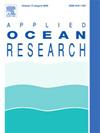基于 AIS 数据的复杂场景下船舶轨迹预测混合深度学习模型
IF 4.3
2区 工程技术
Q1 ENGINEERING, OCEAN
引用次数: 0
摘要
船舶轨迹预测在态势感知和海上安全监控系统中发挥着重要作用。目前,主流的船舶轨迹预测方法主要针对单艘船舶,很少考虑船舶之间的相互作用。因此,为了提高船舶轨迹预测的准确性,并从全面的角度看待海上监控,我们提出了一个包含两个子模型的综合模型。(1) S-TGP 模型,结合了时间卷积网络(TCN)和门控循环单元(GRU),用于高精度和高泛化的单船轨迹预测。S-TGP 模型利用了 TCN 的并行计算能力和估计历史数据中长期相关性的能力。(2) MVS-TGP 模型将变异自动编码器(VAE)与 S-TGP 相结合,用于复杂情况下的多船轨迹预测。我们的贡献包括(1) 利用 S-TGP 模型提高单船轨迹预测的准确性;(2) 利用 MVS-TGP 模型提高多船协同预测能力;以及 (3) 为海上监视提供实时预测和监控能力。通过对三个地区的 AIS 数据进行验证,与现有方法相比,我们的模型表现出更优越的性能和鲁棒性。结果表明,所提出的模型在不同环境下均有效,并在定量和定性方面优于其他模型。本文章由计算机程序翻译,如有差异,请以英文原文为准。
Hybrid deep learning models for ship trajectory prediction in complex scenarios based on AIS data
Ship trajectory prediction plays a vital role in situation awareness and maritime safety monitoring systems. Currently, the mainstream ship trajectory methods focus on single ships, and little work has been done to consider the interaction between ships. Therefore, aiming at improving the ship trajectory prediction accuracy and giving a comprehensive perspective of maritime surveillance, we proposed an integrated model with two sub-models. (1) the S-TGP model, combining Time Convolutional Network (TCN) and Gated Recurrent Unit (GRU) for single-ship trajectory with high accuracy and high generalization. The S-TGP model takes advantage of the parallel computing ability of TCN and the ability to estimate long-term correlation in the historical data. (2) the MVS-TGP model, integrating variational autoencoder (VAE) with S-TGP, for multi-ship trajectory prediction in complex scenarios. Our contributions include: (1) enhancing the accuracy of single-ship trajectory prediction with the S-TGP model; (2) improving collaborative prediction capabilities for multiple ships with the MVS-TGP model; and (3) providing real-time prediction and monitoring capabilities for maritime surveillance. Validated on AIS data from three regions, our models demonstrate superior performance and robustness compared to existing methods. The results show that the proposed models are effective in different environments and outperform the other models quantitively and qualitatively.
求助全文
通过发布文献求助,成功后即可免费获取论文全文。
去求助
来源期刊

Applied Ocean Research
地学-工程:大洋
CiteScore
8.70
自引率
7.00%
发文量
316
审稿时长
59 days
期刊介绍:
The aim of Applied Ocean Research is to encourage the submission of papers that advance the state of knowledge in a range of topics relevant to ocean engineering.
 求助内容:
求助内容: 应助结果提醒方式:
应助结果提醒方式:


